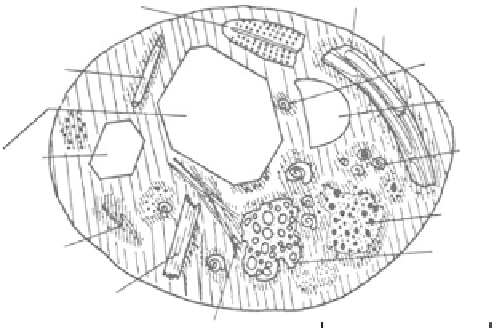Geoscience Reference
In-Depth Information
Plant debris
Fulvic acids
Diatom
Tubular
halloysite
Humic acids
Disc of opal
Glomerular
halloysite
Kaolinite
Granular glass
Smectite
Vesicular glass
Clay mica
5 Micrometres
Imogolite
Fig. 10.8
Theoretical section through a microaggregate in an Andosol showing the various
constituents (Hétier 1975). The internal pore-space is not shown.
Andosols are very poor in clay particles with well-defined outlines.
Also, they are very rich in cements (iron, organic matter) that are hard
to disperse by NaOH, NaCl or ultrasound so that particle-size analysis
counts more of agglomerated particles than elementary particles. Indeed,
for these soils, concepts of texture and particle-size distribution have
no meaning.
When wet, the feel of humiferous Andosols could be 'slimy' or
smeary. When dry, their material is pulverulent and forms a very light
powder of fine-silt size.
Texture
Andosols have an amazing affinity for water. Whereas an ordinary
soil when drained retains 20 to 40 per cent water, Andosols of perudic
moisture regime (Soil Taxonomy) could retain 300 per cent or more.
Figure 10.9 gives an example extracted from the thesis of Rosello (1984).
It is seen that at pF 4.2, at the water content where many plants start to
wilt, the Andosol in question (from Reunion) still contains more than
150 per cent water (dashed arrows).
Water retention progressively diminishes with applied tension, which
indicates that the pores are of all sizes. This strong retention of water
has these practical consequences:
Water retention
If a sample is drawn and allowed to dry, it loses literally one-half
or three-fourths of its weight.

